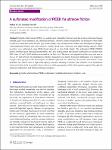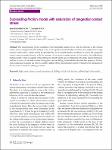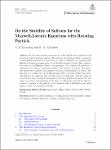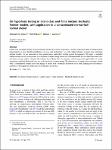Search
Author
- Osman, Ahmed I. (5)
- Daqing, Ma (3)
- Jorgensen, Ed (3)
- Li, Yan (3)
- next >
Subject
- kinh tế (26)
- Economics (12)
- programming (10)
- XRD (10)
- next >
Date issued
- 2020 - 2025 (2128)
- 2010 - 2019 (129)
- 2000 - 2009 (9)
- 1999 - 1999 (1)
Has File(s)
Search Results
Due to their unique characteristics, knowledge-intensive processes (KiPs) are difficult to capture with conventional modeling and management approaches. One such KiP is the advanced therapy medicinal product (ATMP) development process. ATMPs are highly innovative medicinal products that are based on biomedical technology. ATMP development processes need to comply with complex regulatory frameworks. Currently, biomedical scientists that develop ATMPs manage the regulatory aspects of the ATMP development processes in an ad hoc fashion, resulting in inefficiencies such as reworks or even withdrawal of ATMPs from the market. |
The retailers’ goals to maximize the profit of the products in stores are realized on the planogram shelves. In this paper, we investigated a practical shelf space allocation model with a visible horizontal and vertical grouping of products into categories, which takes into account the number of facings, capping and nesting of a product. The result is four groups of constraints, such as shelf constraints, product constraints, multi-shelves constraints, and category constraints that are used in the model. We proposed 6 heuristics to solve the planogram profit maximization problem. The developed techniques on which heuristics are based may be applied to other category of management shelf space allocation problems because all of them share the same nature of the problem, i.e., the init... |
In this paper, we prove uniform error bounds for proper orthogonal decomposition (POD) reduced order modeling (ROM) of Burgers equation, considering difference quotients (DQs), introduced in Kunisch and Volkwein (Numer Math 90(1):117–148, 2001). In particular, we study the behavior of the DQ ROM error bounds by considering L2(Ω) and H10(Ω) POD spaces and l∞(L2) and natural-norm errors. We present some meaningful numerical tests checking the behavior of error bounds. |
Polyether ether ketone (PEEK) is a widely used material for friction pairs due to its excellent mechanical strength, good wear resistance, and chemical inertness. However, some modifications are necessary when PEEK is used as a water-lubricated friction pair. In this study, a novel sulfonation method was developed to design a water-lubricated friction pair with ultralow friction, good wear resistance, and high loading capacity. PEEK powders were sulfonated using ClSO3H and sintered to form bulk plastic. The sulfonated PEEK (SPEEK) plastic exhibited good tribological properties. At a low sliding speed, the friction coefficient was smaller than 0.02 when a 3 wt% NaCl solution was used as the lubricant. The order of magnitude of the wear rate was as low as 10−8 mm3/(N·m). |
The incorporation of the saturation of the tangential contact stress with the increase of the normal contact stress is required for the analysis of the friction phenomenon of solids and structures subjected to a high normal contact stress, which cannot be described by the Coulomb friction condition, in which the tangential contact stress increases linearly with the increase of the normal contact stress. In this article, the subloading-friction model, which is capable of describing the smooth elastic—plastic transition, the static—kinetic transition, and the recovery of the static friction during the cease of sliding, is extended to describe this property. Further, some numerical examples are shown, and the validity of the present model will be verified by the simulation of the test ... |
We prove the stability of solitons of the Maxwell–Lorentz equations with extended charged rotating particle. The solitons are solutions which correspond to the uniform rotation of the particle. To prove the stability, we construct the Hamilton–Poisson representation of the Maxwell–Lorentz system. The construction relies on the Hamilton least action principle. The constructed structure is degenerate and admits a functional family of the Casimir invariants. This structure allows us to construct the Lyapunov function corresponding to a soliton. The function is a combination of the Hamiltonian with a suitable Casimir invariant. The function is conserved, and the soliton is its critical point. The key point of the proof is a lower bound for the Lyapunov function. |
Recent disastrous events, such as the COVID-19 pandemic, has amplified the appeal for compassionate leadership in organizations and is viewed as the need of the hour. While compassion is a timeless concept, there appears to be a lack of clarity around the idea of compassionate leadership, and the current understanding appears limited, fragmented, and scattered across the literature. This integrative systematic review of 41 articles during the last 20 years (2002–2021) conceptualizes six critical dimensions of compassionate leadership, namely: empathy; openness and communication; physical, mental health and well-being; inclusiveness; integrity; respect and dignity. |
Qualitative spatial/temporal reasoning (QSR/QTR) plays a key role in research on human cognition, e.g., as it relates to navigation, as well as in work on robotics and artificial intelligence. Although previous work has mainly focused on various spatial and temporal calculi, more recently representation learning techniques such as embedding have been applied to reasoning and inference tasks such as query answering and knowledge base completion. These subsymbolic and learnable representations are well suited for handling noise and efficiency problems that plagued prior work. |
This paper studies convex generalized Nash equilibrium problems that are given by polynomials. We use rational and parametric expressions for Lagrange multipliers to formulate efficient polynomial optimization for computing generalized Nash equilibria (GNEs). The Moment-SOS hierarchy of semidefinite relaxations are used to solve the polynomial optimization. Under some general assumptions, we prove the method can find a GNE if there exists one, or detect nonexistence of GNEs. Numerical experiments are presented to show the efficiency of the method. |
Latent class and finite mixture stochastic frontier models have been proposed as a means of allowing either for technological heterogeneity or more flexible distributions of noise and inefficiency. As in the wider literature on latent class and finite mixture models, we are interested in class enumeration, particularly testing against homogeneity. We apply a modified likelihood ratio test for homogeneity in a stochastic frontier setting, based on established results for non-Gaussian latent class and finite mixture models, and provide evidence from Monte Carlo experiments which suggest the applicability of results regarding a modified likelihood ratio test to the stochastic frontier setting. We demonstrate an application to testing a model with a contaminated normal noise term agains... |










